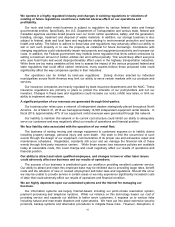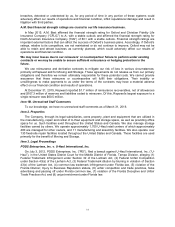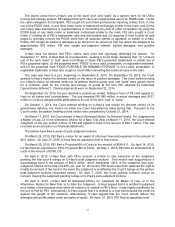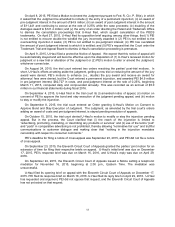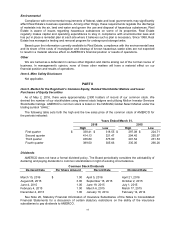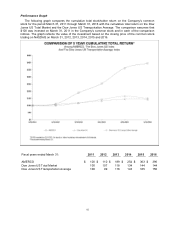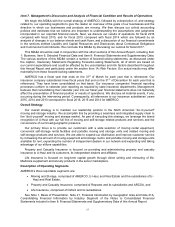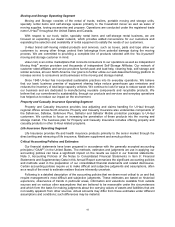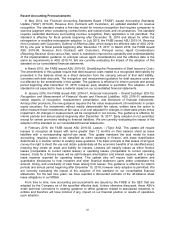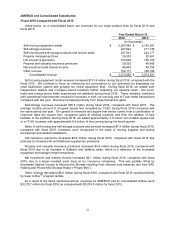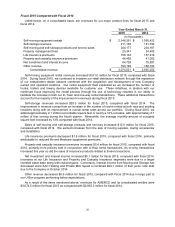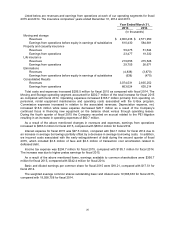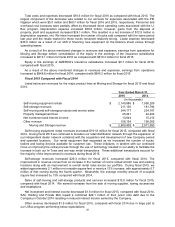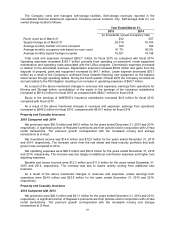U-Haul 2016 Annual Report Download - page 26
Download and view the complete annual report
Please find page 26 of the 2016 U-Haul annual report below. You can navigate through the pages in the report by either clicking on the pages listed below, or by using the keyword search tool below to find specific information within the annual report.20
Management determined that additions to the fleet resulting from purchases should be depreciated on
an accelerated method based upon a declining formula. Under the declining balances method (2.4 times
declining balance), the book value of a rental truck is reduced by approximately 16%, 13%, 11%, 9%, 8%,
7%, and 6% during years one through seven, respectively, and then reduced on a straight line basis to a
salvage value of 20% by the end of year fifteen. Beginning in October 2012, new purchased rental
equipment subject to this depreciation schedule is depreciated to a salvage value of 15%. Comparatively,
a standard straight line approach would reduce the book value by approximately 5.7% per year over the
life of the truck.
Although we intend to sell our used vehicles for prices approximating book value, the extent to which
we realize a gain or loss on the sale of used vehicles is dependent upon various factors including but not
limited to, the general state of the used vehicle market, the age and condition of the vehicle at the time of
its disposal and the depreciation rates with respect to the vehicle. We typically sell our used vehicles at
our sales centers throughout North America, on our web site at uhaul.com/trucksales or by phone at 1-
866-404-0355. Additionally, we sell a large portion of our pickup and cargo van fleet at automobile dealer
auctions.
Insurance Reserves
Liabilities for life insurance and certain annuity and health policies are established to meet the
estimated future obligations of policies in force, and are based on mortality, morbidity and withdrawal
assumptions from recognized actuarial tables which contain margins for adverse deviation. In addition,
liabilities for health, disability and other policies include estimates of payments to be made on insurance
claims for reported losses and estimates of losses incurred, but not yet reported. Liabilities for annuity
contracts consist of contract account balances that accrue to the benefit of the policyholders.
Insurance reserves for Property and Casualty Insurance and U-Haul take into account losses incurred
based upon actuarial estimates and are management’s best approximation of future payments. These
estimates are based upon past claims experience and current claim trends as well as social and
economic conditions such as changes in legal theories and inflation. These reserves consist of case
reserves for reported losses and a provision for losses incurred but not reported (“IBNR”), both reduced
by applicable reinsurance recoverables, resulting in a net liability.
Due to the nature of the underlying risks and high degree of uncertainty associated with the
determination of the liability for future policy benefits and claims, the amounts to be ultimately paid to
settle these liabilities cannot be precisely determined and may vary significantly from the estimated
liability, especially for long-tailed casualty lines of business such as excess workers’ compensation. As a
result of the long-tailed nature of the excess workers’ compensation policies written by Repwest during
1983 through 2001, it may take a number of years for claims to be fully reported and finally settled.
On a regular basis insurance reserve adequacy is reviewed by management to determine if existing
assumptions need to be updated. In determining the assumptions for calculating workers’ compensation
reserves, management considers multiple factors including the following:
Claimant longevity
Cost trends associated with claimant treatments
Changes in ceding entity and third party administrator reporting practices
Changes in environmental factors including legal and regulatory
Current conditions affecting claim settlements
Future economic conditions including inflation
We have reserved each claim based upon the accumulation of current claim costs projected through
each claimant’s life expectancy, and then adjusted for applicable reinsurance arrangements.
Management reviews each claim bi-annually to determine if the estimated life-time claim costs have
increased and then adjusts the reserve estimate accordingly at that time. We have factored in an
estimate of what the potential cost increases could be in our IBNR liability. We have not assumed
settlement of the existing claims in calculating the reserve amount, unless it is in the final stages of
completion.


